Echeveria is a diverse, captivating genus of succulent plants. This genus is known for its stunning rosette-shaped foliage and charming flowers. Native to arid regions of Central America, particularly Mexico, Echeverias have evolved to thrive in dry, sunny environments.
This is a large genus of succulent plants belonging to the Crassulaceae family. Succulent enthusiasts love their striking rosette-shaped leaves, beautiful colors and easy care requirements. However you use them, these beautiful plants add a touch of elegance and natural beauty to your setting.
This genus is large and includes many types of species that have different growth habits, including offsetting and trailing varieties. Their is a wide range of colors, sizes (2 to 12 inches), and textures.
They are all arid plants that love the light and low humidity. And like other succulents, their fleshy leaves store water, allowing them to withstand periods of drought.

Uses For Echeveria plants:
Echeveria plants are incredibly versatile and can be used in various ways with their diverse colors and growth habits. Here are some popular ways to use Echeverias:
Succulent Arrangements and Dish Gardens:
- Echeverias look fantastic in succulent arrangements or dish gardens. Combining different Echeveria species and hybrids with other complementary succulents can create beautiful and eye-catching displays. Arrange the plants creatively to show off their interesting colors, shapes and textures.
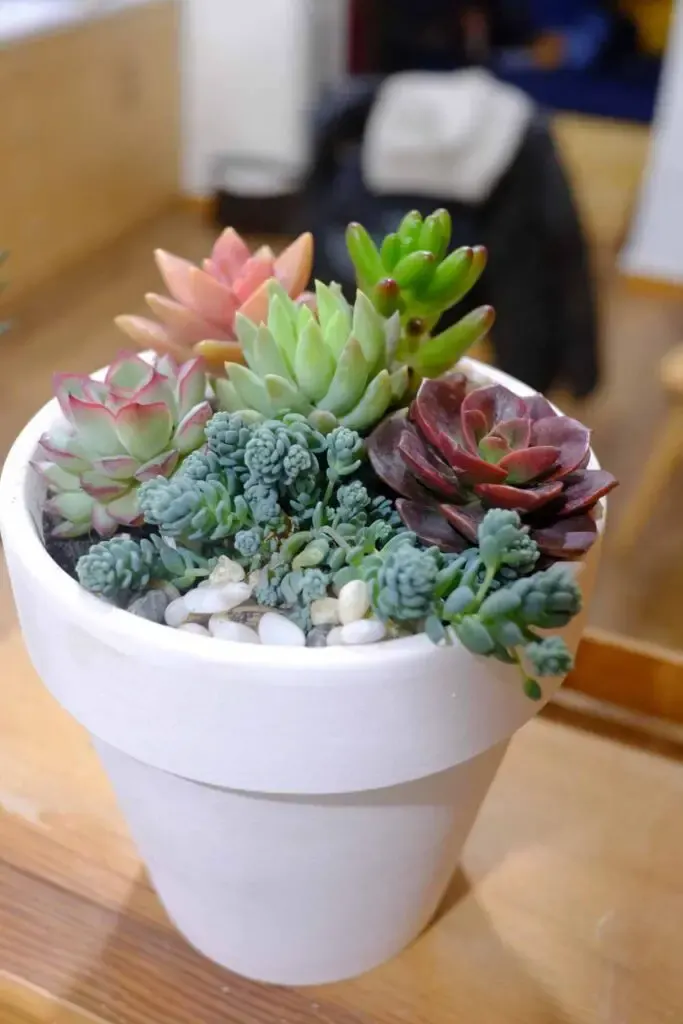
Echeveria Container Gardens:
- Planting Echeverias in individual pots or containers will showcase their unique rosette forms and colors on the patio and indoors. Choose pots that are good candidates for succulents. Read our post on best succulent pots for pointers.
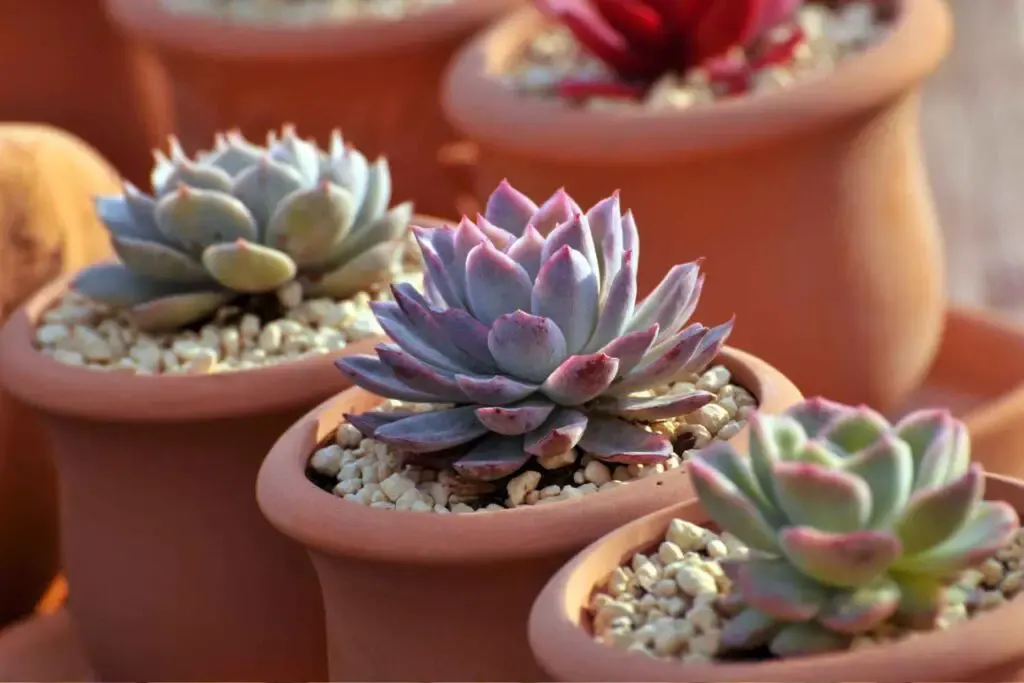
Rock Gardens:
- Echeverias are a great addition to rock gardens. Their low-growing rosettes and drought tolerance make them perfect for growing among rocks and gravel. Create a naturalistic landscape by combining Echeverias with other succulents, small shrubs, and native plants.
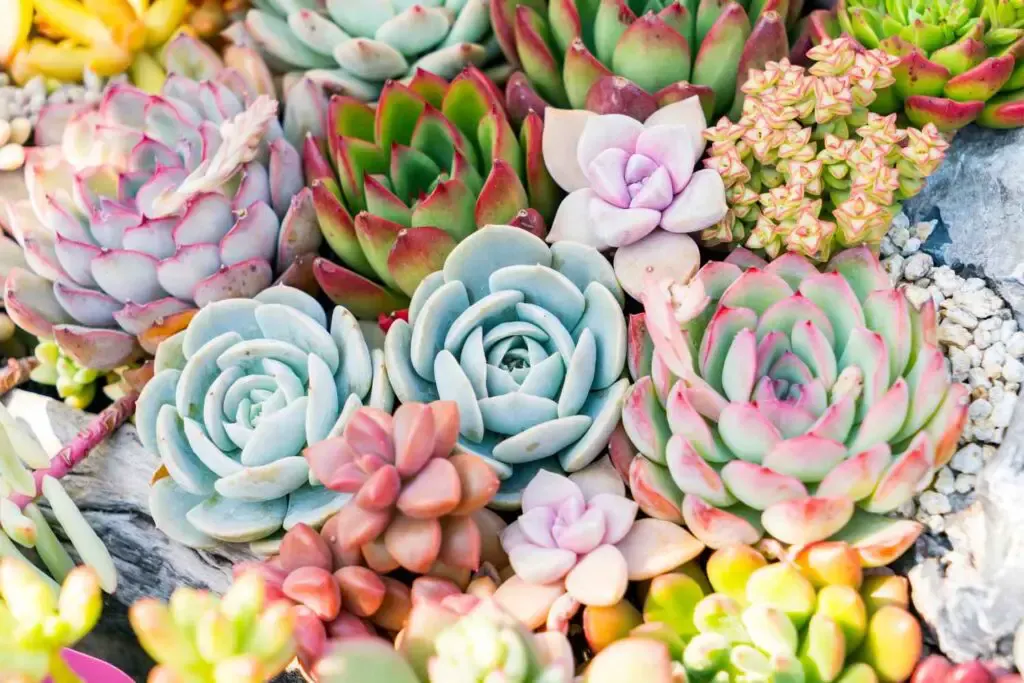
Ground Cover:
- Echeveria species with spreading growth habits are great as ground covers. They can be used to fill gaps between larger plants or along pathways, adding a touch of texture and color to the landscape.
Mixed Borders:
- Echeverias can be incorporated into mixed borders or flowerbeds, blending with other drought-tolerant plants to create a visually appealing and low-maintenance garden.
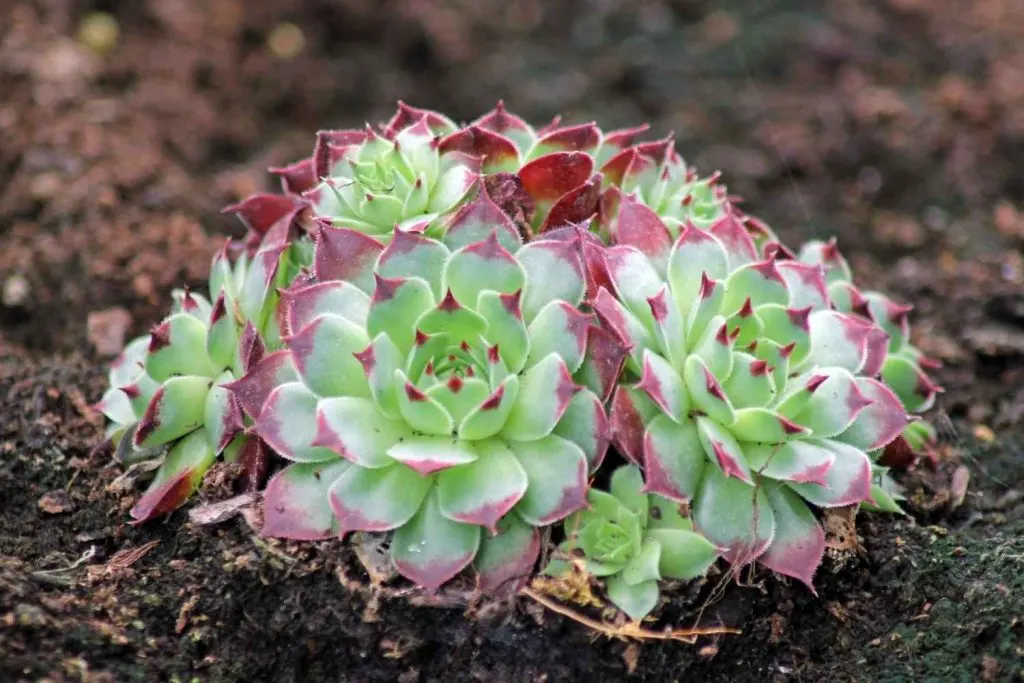
Vertical Gardens and Living Walls:
Some varieties of this genus can be used in vertical gardens or living walls, especially those with trailing or cascading growth habits. Plant them in pockets or containers on a vertical structure to create a living work of art.
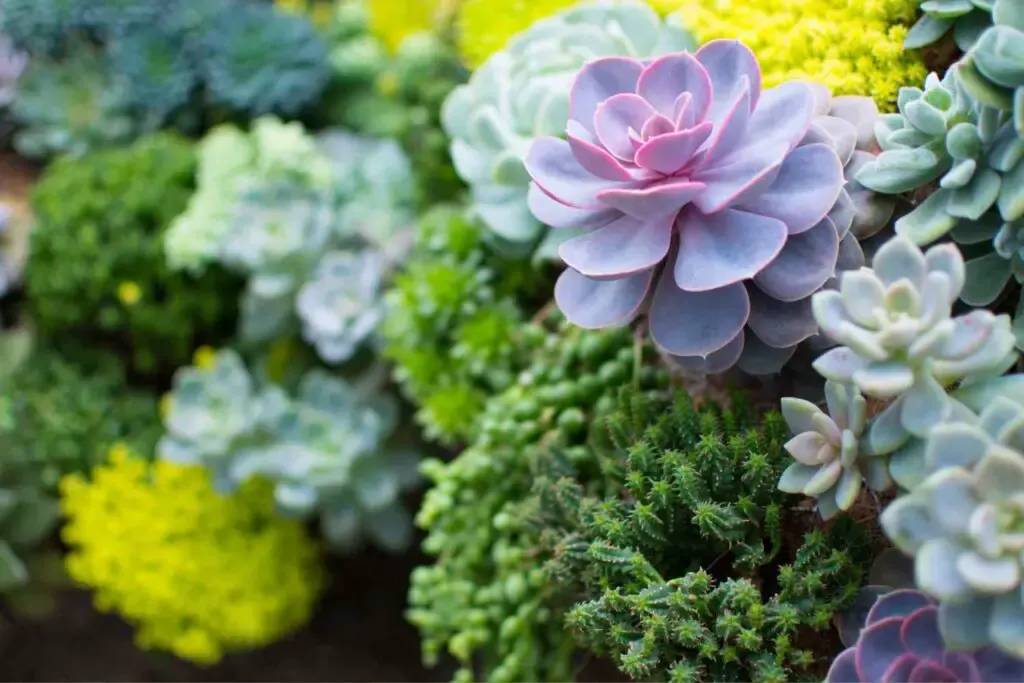
When creating a wall garden or living wall with Echeveria plants select varieties that have trailing or cascading growth habits. These types of Echeverias are well-suited for vertical gardens because their stems can gracefully drape down the wall, creating a beautiful cascading effect.
Here are some Echeveria varieties that make excellent choices for wall gardens:
- Echeveria ‘Blue Waves’: This cultivar has powdery blue, wavy leaves that form a compact rosette. It also produces numerous offsets that cascade down the wall as the plant matures.
- Echeveria ‘Doris Taylor’: This variety has fuzzy, elongated leaves with a silver-green color. It’s a fast-growing Echeveria that works well as a trailing element in wall gardens.
- Echeveria elegans (Mexican Snowball): This Echeveria forms tight rosettes of soft, powdery blue-gray leaves. Over time, it can produce multiple offsets that trail down the wall.
- Echeveria ‘Perle von Nürnberg’: This popular Echeveria has beautiful pastel hues of purple and pink. It’s a versatile variety that can be used in various garden arrangements, including wall gardens.
- Echeveria gibbiflora ‘Metallica’: This Echeveria has large rosettes with metallic silver-green leaves. It produces offsets that hang gracefully down the sides of the container or wall garden.
- Echeveria secunda (Hens and Chicks): As mentioned earlier, Echeveria secunda, commonly known as hens and chicks, is a natural choice for wall gardens due to its propensity to produce numerous offsets that cascade over time.
When creating a wall garden with Echeveria plants, it’s essential to use a vertical gardening system that provides good support and proper drainage. You can use specially designed vertical planters, hanging containers, or wall-mounted planter boxes. Ensure that the soil mix is well-draining and suitable for succulents to prevent waterlogging.
Fairy Gardens and Miniature Landscapes:
Creating fairy gardens and miniature landscapes with Echeveria plants allows for endless creativity and enchantment. Often these miniature gardens use an artful tree stump or rock formation for a background and the display is laid on top of them or, in the case of stumps, can be carved right into and on top of them as well.
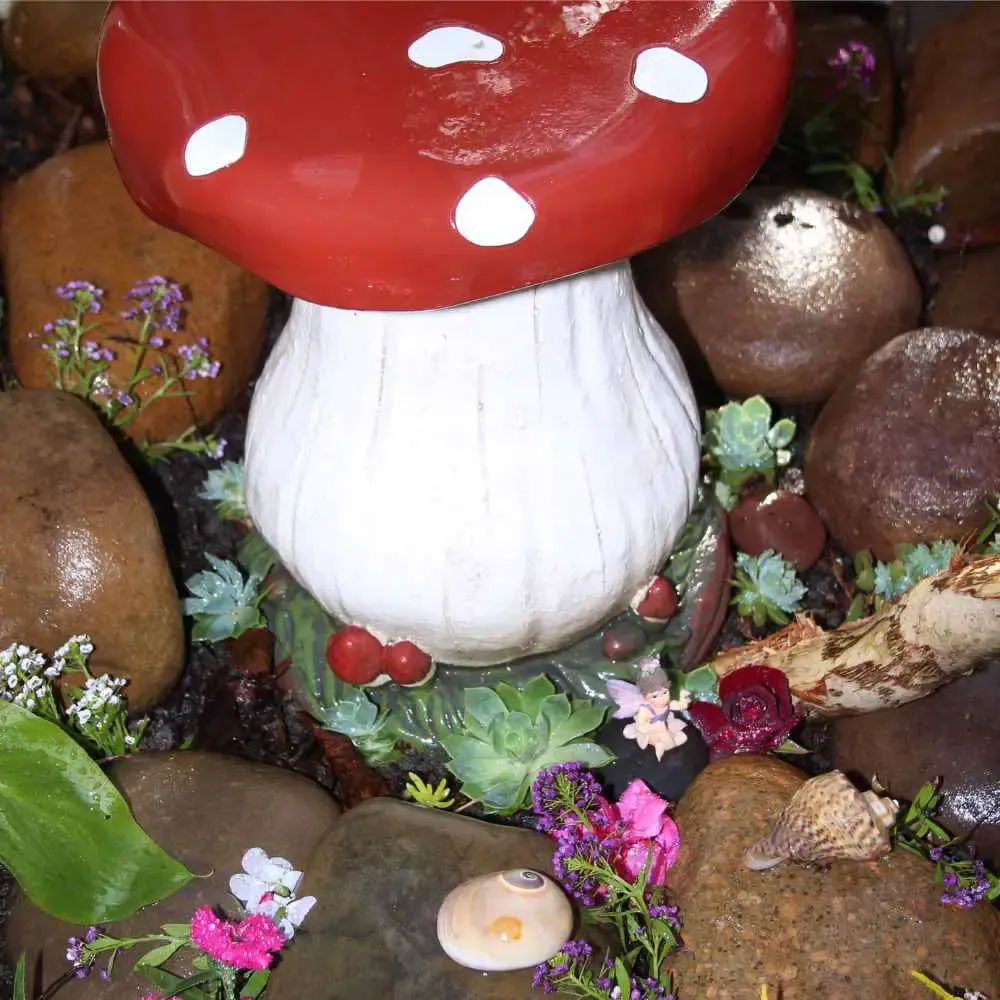
Set these small succulent plants into shallow containers or small pots with well-draining soil wherever you need to place them in your scene. With their intricate forms and compact size are great for fillers, extra texture and color spots in busy miniature gardens.
Use these plants to enhance and set off other tiny elements such as miniature fairy figurines, tiny mushrooms, and decorative stones to complete the magical scene and tell a whimsical story.
Here are some Echeveria varieties that make excellent choices for these whimsical and magical miniature settings: Mix and match different Echeverias to create diverse arrangements.
- Echeveria ‘Minima’: As the name suggests, ‘Minima’ is a tiny Echeveria with compact rosettes, making it a perfect choice for tiny landscapes. Its green leaves have a powdery coating, adding to its charm.
- Echeveria ‘Neon Breakers’: This small variety features striking rosettes with bright green and pink colors, adding a splash of color to fairy gardens.
- Echeveria ‘Raindrops’: ‘Raindrops’ has small, chubby rosettes with silvery-blue leaves that resemble raindrops. Its unique appearance adds a sense of wonder to miniature landscapes.
- Echeveria ‘Violet Queen’: With its beautiful shades of violet and pink, ‘Violet Queen’ adds a touch of royalty to fairy gardens. Its compact growth habit makes it easy to incorporate into small spaces.
- Echeveria ‘Topsy Turvy’: This quirky Echeveria has rosettes with leaves that curl upwards, creating an interesting and playful appearance. It adds character and personality to miniature landscapes.
- Echeveria ‘Tippy’: ‘Tippy’ features cute rosettes with blue-green leaves that have red tips. Its tiny size and adorable appearance make it an ideal choice for fairy gardens.
- Echeveria ‘Perle von Nürnberg’: This popular variety, known for its pastel hues of lavender and pink, can add a touch of elegance and sophistication to fairy gardens.
Remember to place your miniature Echeveria garden in a location with bright, indirect light, as these plants still require adequate sunlight to thrive even in small settings. With the right care and creativity, your miniature landscapes with Echeverias will be sure to captivate the imagination and bring joy to anyone who encounters them.

Indoor Decor and Centerpieces:
Echeveria plants are wonderful indoor plants and have a lot to add as part of home decor or table centerpieces. Placing a single Echeveria in a decorative pot or incorporating them into floral arrangements can add a touch of nature and color to your living spaces.

When choosing Echeverias as centerpiece plants, you’ll want to look for varieties that have striking colors, attractive rosette shapes, and a moderate size that doesn’t overwhelm the table or display. Here are some Echeveria varieties that make excellent choices for centerpiece plants:
- Echeveria ‘Lola’: Has beautiful pastel hues of pink and blue, with ruffled leaves that form a compact rosette. ‘Lola’ adds an elegant and feminine touch to any centerpiece arrangement.
- Echeveria ‘Black Prince’: With its dark, almost black foliage, ‘Black Prince’ is a dramatic choice for centerpieces. The contrast between its dark leaves and bright green centers creates an eye-catching display.
- Echeveria ‘Perle von Nürnberg’: This popular variety features lovely lavender and pink shades, making it a soft and enchanting addition to any centerpiece. Its compact rosettes create a harmonious and balanced look.
- Echeveria ‘Dusty Rose’: As the name suggests, ‘Dusty Rose’ showcases dusty pink to lavender colors with a powdery coating on the leaves. It adds a touch of romance and elegance to centerpieces.
- Echeveria elegans (Mexican Snowball): With its soft, powdery blue-gray leaves, Echeveria elegans creates a subtle and soothing centerpiece. Its compact rosettes are charming and versatile.
- Echeveria agavoides (Lipstick Echeveria): This variety has distinctive triangle-shaped leaves with red edges, resembling a lipstick. ‘Lipstick Echeveria’ brings a pop of color and visual interest to centerpieces.
- Echeveria ‘Blue Curls’: With its curly, silvery-blue leaves, ‘Blue Curls’ is a unique and eye-catching centerpiece choice. Its textural appeal adds a touch of whimsy to any arrangement.
Remember that the size of the centerpiece and the number of Echeverias you include will depend on the size of the table or display and your overall design vision. For larger centerpieces, you can mix and match different Echeveria varieties to create a diverse and captivating arrangement.
When using Echeverias as centerpieces, ensure they are planted in containers with proper drainage. If you’re creating a temporary centerpiece, you can use decorative pots or containers. For a more long-term display, consider using a centerpiece tray or dish garden.
With their stunning colors, unique shapes, and overall elegance, Echeverias can add a touch of natural beauty and sophistication to any centerpiece arrangement.
Wedding and Event Decorations:
Echeverias are popular choices for wedding and event decorations. They can be used as table centerpieces, in bridal bouquets, boutonnieres, or even as part of wedding favors.
When using Echeverias in various arrangements, consider their color, form, and growth habits to create aesthetically pleasing combinations. Ensure that they are planted in well-draining soil and provided with the right amount of sunlight to thrive and showcase their beauty. Whether you prefer individual specimens or groupings, Echeveria plants can add a touch of elegance and charm to any setting.

Echeveria plants can be a delightful addition to wedding bouquets and receptions. They add a touch of uniqueness, elegance, and natural charm. Here are some creative ways to incorporate Echeverias into wedding floral arrangements and decorations:
1. Bouquets: Echeverias make a good focal point or an eye-catching accent in bridal bouquets. Their rosette shapes and various colors offer a striking contrast to traditional floral elements. Combine Echeverias with flowers like roses, peonies, and succulent-friendly blooms like dianthus and astilbe for a stunning and unforgettable bouquet.
2. Boutonnieres: For groomsmen and male wedding party members, use small Echeveria rosettes as boutonnieres. They will add a touch of nature and sophistication to the men’s attire.
3. Centerpieces: Incorporate Echeverias into wedding reception centerpieces to create a unique and memorable display. Place them in vases or containers alongside cut flowers or mix them with other succulents and greenery for a rustic, charming look.
4. Table Settings: Use individual Echeveria rosettes as place card holders or table settings. Tie small tags with guests’ names around the plants for a personalized touch.
5. Cake Toppers: Crown the wedding cake with a few Echeveria rosettes for a fresh and trendy cake topper. They add a natural and organic touch to the dessert.
6. Hanging Decorations: Create suspended installations with Echeverias hanging from overhead structures or arches. Their trailing or cascading varieties can be used to form lovely living chandeliers or greenery curtains.
7. Favors: Miniature Echeveria rosettes in small pots or containers make excellent wedding favors for guests. They can take these living souvenirs home to plant and remember the special day.
8. Floral Crowns: Incorporate small Echeveria rosettes into bridal and bridesmaid floral crowns for a boho-chic and natural look. They blend beautifully with other flowers and greenery.
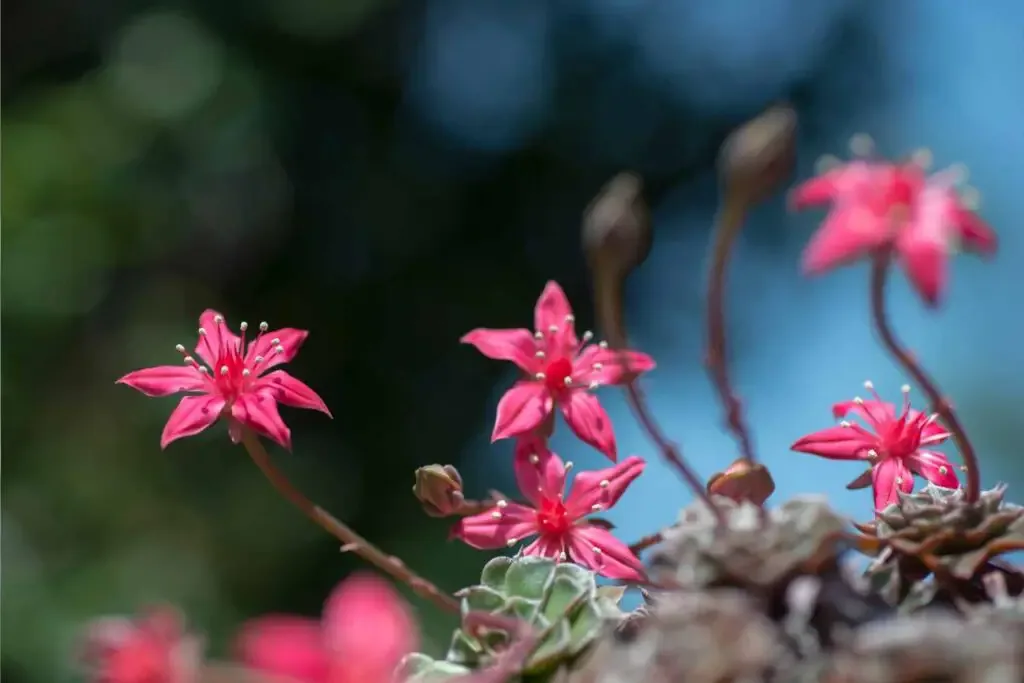
Echeveria Flowers:
Echeveria plants are known for their beautiful and often showy flowers, which add an extra touch of charm to their already stunning rosettes. While the main attraction of Echeverias is usually their colorful and intricate leaves, their flowers are equally impressive. Here are some reason why:
- Flower Structure: Echeveria flowers are generally bell or urn-shaped. The inflorescences(flower stalks) rise above the rosettes, showing off the flowers to both pollinators and people.
- Inflorescence Height: The height of the inflorescence can vary depending on the Echeveria species. In some varieties, the flower stalks can be relatively short and sit close to the rosettes, while in others, the inflorescences can be taller, rising above the foliage.
- Color: Echeveria flowers come in a wide range of colors, including shades of pink, red, orange, yellow, purple, white, and bi-color combinations. The flowers can be solid in color or feature gradients or contrasting edges. It’s all part of why we enjoy these succulent plants so much.
- Blooming Season: Echeveria flowers usually bloom during the spring and summer months, depending on the species and growing conditions. The flowering period can last for several weeks, and some varieties may continue to produce flowers throughout the growing season.
- Attractiveness to Pollinators: The flowers of Echeveria plants are attractive to pollinators, such as bees, butterflies, and hummingbirds. Local pollinators are drawn to the nectar-rich blooms, which serve as a food source for them.
- Scent: Some Echeveria species produce fragrant flowers, adding yet another reason to love them. The scent can vary from sweet and floral to subtle and spicy.
With adequate sunlight and proper care, Echeverias are likely to produce abundant, vibrant flowers. The flowers can vary significantly between different Echeveria species and hybrids. A wonderful surprise for succulent enthusiasts and gardeners.
While the flowers of Echeverias are captivating, flowers are a bonus rather then the primary reason for growing these plants. Echeverias are grown for their striking rosettes and attractive foliage, which can provide year-round interest and color in gardens, containers, and arrangements.
Sourcing Echeveria Succulents:
You can find species of Echeveria easily in your local garden shops in the succulents section if they have one. If you want a more exotic variety or you want to explore just what is available we suggest you shop on ETSY. It’s run by shop family shops that know the products they sell and are experienced shippers.
We like and have used Queen of succulents (linked below) for our cactus and succulent shopping online. This is a VERY well reviewed and established shop and our experience with them was stellar.
How to Care For Echeveria Plants:
Our printable care guide below is full of details on caring for these wonderful plants and getting the most out of them.
Echeveria succulents Care guide
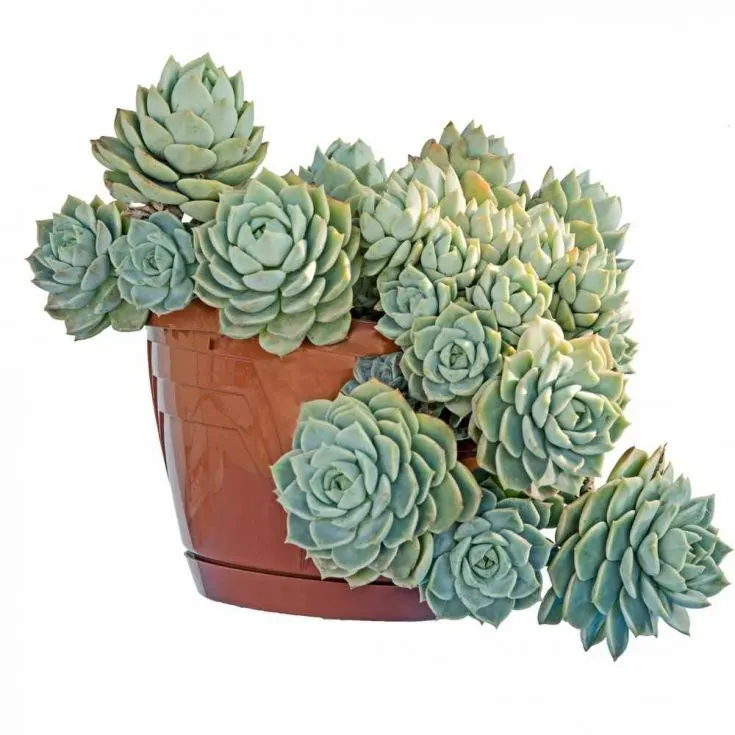
Echeveria succulent genus has a myriad of different species offering unique colors and styles.
These plant have fleshy globular leaves the grow in a rosette pattern. Echeveria plants will flower in good conditions.
This Care Guide will teach you how to keep Echeverias happy all through the year.
Materials
Instructions
Soil Preference:
- Echeveria succulents prefer a well draining cactus soil mix. The roots will rot quickly if they sit in moist soil.
- A mix of cactus potting mix, sand and perlite will keep the roots happiest.
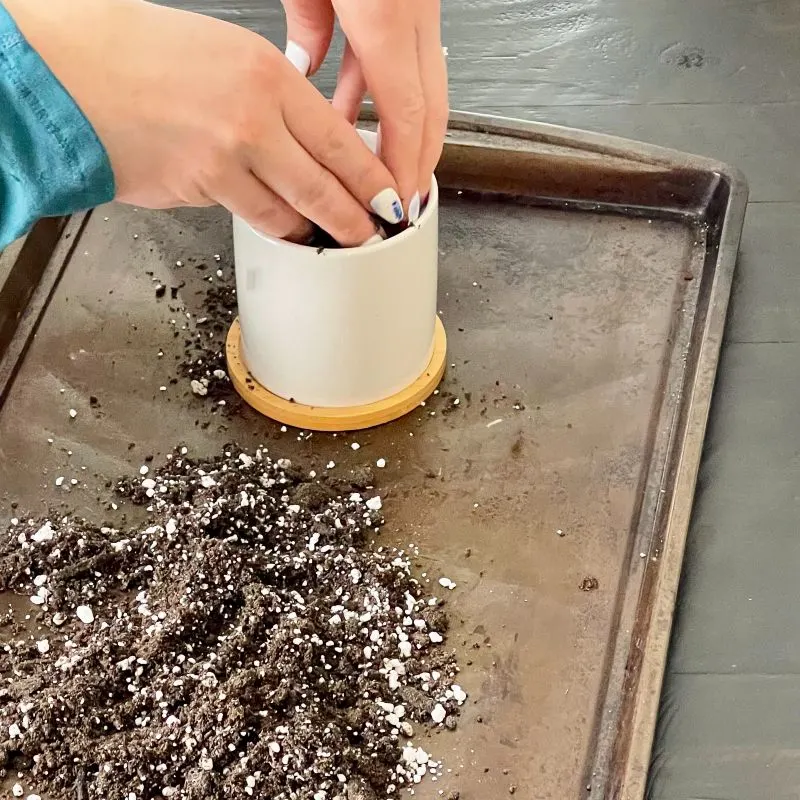 . Read our post on how to make a the best potting soil for succulents for more on this,.
. Read our post on how to make a the best potting soil for succulents for more on this,. - Make sure your pot has drainage at the bottom. Do not use a pot with no drainage hole for this plant.
- A heavy soil potting mix is not recommended for succulent plants.
Pot Size and Type:
- Echeveria plants grow well in many different kinds of pots, I like to plant mine in ceramic pots with a drainage hole. I linked an Amazon page of adorable cactus pots above for you.
- Repot every second year or when roots come out the drainage holes on the pot bottom To the next pot size up. Don't jump to a huge pot from a small one. Just go to the next size up pot.
- Shallow rectangular or round pots are perfect for hens and chicks since this plant crawls and drapes orver planter edges.
- Large shallow posts allow this ground cover to form masses, which it naturally wants to do.
Lighting:
- These plants will grow best in bright light for 6 to 8 hours a day.
- Set these succulents in a south or west window where it can recieve direct light. If the plant shows signs of burning set it back further.
Watering:
- Water Echeveria succulent plants when the soil is dry. They are drough resistant and can withstand long periods of dryness.
- Watering is best done by drenching the plant thoroughly. Allow the water to run through the pot and then let it drain so no water sits in the bottom drain plate.
- Do not allow water to sit in the center of the leaves and accumulate.This can cause crown rot at the leaf intersections.
- The recommendation watering cycle is every 2-3 weeks.
- Never let this plant get wet feet. Overwatering encourages root rot and fungus gnats.
How to Fertilize:
- Apply a fertilizer (linked in materials) diluted by 50% once in the summer months.Echeveria plants do not need much fertilizer.
- Allow the plant to rest through the winter months with no fertilizer.
Temperature:
- These plants will do best in temperatures between 30-85 degrees F. For this reason they can grow outdoors in climate zones 10a to 11b. They may survive in temperate climate with colder winters, but will die in sustained periods of intense freeze.
Pests:
- For the most part Echeveria plants are hardy resilient plants. However all plants can get attacked by pests.
- Stress by longterm overwatering, poor light, extreme temperatures and soil conditions are contributors to plant stress..
- Spider mites, mealy bugs, scale, thrips and whitefly are the most common houseplant pests you will see. Read our post on the seven most common pests and how to eradicate them for more on this.
- Read our post on How to get rid of aphids and other pests with our homemade pesticide soap recipe or neems oil.
- To minimize the possibility of pests be sure to check all nursery plants before bringing them home.
- Quarantine all new plants until you are sure no pests live in them.
How to Propagate:
Echeveria plants are simple to propagate. Several methods work well. Here are three common ways to propagate these succulents:
How to Propagate by Offsets::
- Many Echeveria plants, like the hens and chicks, naturally grow new plants around their outer perimeter. These are called chicks, or offsets.
- You can easily unpot your plant and pull the offsets off the hen (mother) plant.
- Repot the rooted offsets in separate pots in cactus soil.
- Water thoroughly. They should settle in fine.2.
Leaf Cuttings:
- Gently twist a healthy leaf from the mother plant, ensuring that the leaf is intact and undamaged.
- Allow the leaf cutting to dry and callus over for a day or two.
- Place the leaf on top of the soil in a well-draining pot or tray. You can use a succulent propagation tray or a small container filled with succulent mix.
- Keep the soil slightly moist, misting the cutting occasionally to maintain some humidity.
- After a few weeks, tiny plantlets should start forming at the base of the leaf. Once they grow large enough to handle, you can transplant them into individual pots.
To propagate using seeds:
- Collect seeds from a mature Echeveria plant.
- Sow the seeds in a well-draining seed-starting mix or a mix designed for succulent propagation. Keep the soil consistently moist but not waterlogged.
- Place the container in a warm and bright location, but avoid direct sunlight until the seedlings are established.
- Once the seedlings have grown large enough, transplant them into individual pots.
Remember that propagating succulents takes time, and not all leaves or offsets may successfully develop into new plants. Be patient and if you provide the right conditions for the propagation process, they should grow.
Once the new plants are established, continue caring for them as you would for mature Echeveria plants. Over time, your propagations will grow and form beautiful rosettes.
Notes
Echeveria genus if full of plants that are rewarding to grow and a perfect plant for a beginner succulent parent. This plant will grow beautifully with just a little bit of care.
TIP: This plant loves air flow. Don't group it with a lot of other humid loving plants. An open window nearby with warm dry air will keep it happy through the warm months.
The video below is for the Zebra plant. However, the care needs of the Echeveria plants are very similar.
Follow Us:
Find us on YouTube, Instagram , Pinterest and TikTok! We love to Plant chat. We also comment, like and occasionally share your content to our daily stories. We’d love to see your plants. Share your joy in your houseplants. Happy Planting!

